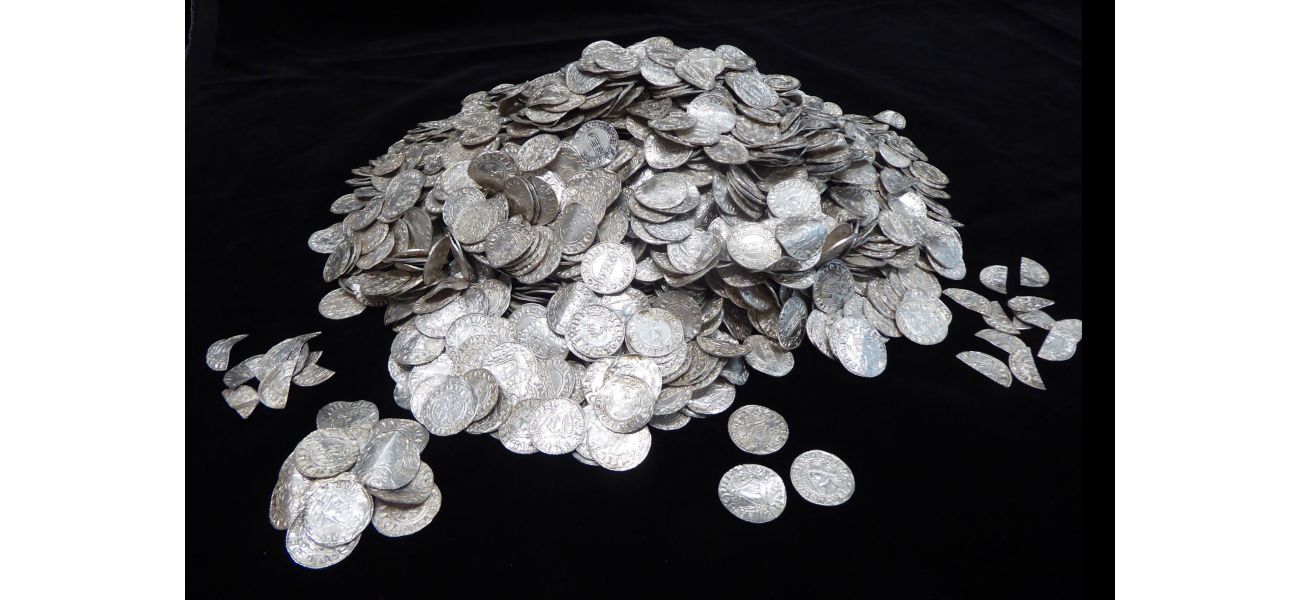A group of seven treasure seekers discover ancient coins and make £4,300,000 by selling them.
Ancient discovery from 1,000 years ago.
October 22nd 2024.

In January 2019, a remarkable discovery was made by a team of seven treasure hunters in the Chew Valley area of Somerset. This group of adventurous individuals, led by Adam Staples and his girlfriend at the time, Lisa Grace, stumbled upon a hoard of silver coins dating back 1,000 years. It was an incredible find, valued at a record-breaking £4.3 million, making these hunters now a lot richer.
The majority of the coins were uncovered by Adam and Lisa, along with five of their friends. But even though they had struck gold, it took them five long years to actually receive any of the money. As Adam, who works as an auctioneer in Derby, explains, "It's like winning the lottery, but then you can't cash the ticket for five years." It was a frustrating wait, but a small price to pay for such a monumental discovery.
Adam recalls the surreal experience of driving through the gates of the British Museum with millions of pounds worth of coins in the back of their car, just days after the hoard was found. However, due to the pandemic, there was a five-year silence before they were finally able to publicly unveil their treasure. But despite the delay, Adam and Lisa still feel incredibly grateful and fortunate to have made such a remarkable find.
Thanks to the hoard, Adam and Lisa are now able to live mortgage-free, having recently purchased a new home. The couple, along with their friends, will each receive around £300,000 from the treasure. But even with this newfound wealth, Adam has not given up on his passion for hunting for more hidden treasures. In fact, he went on his last hunt just last Sunday.
The hoard, which includes coins from the reigns of Harold II and William the Conqueror, has been put on display at the British Museum in London. After that, it will travel to various museums across the UK before finding a permanent home at the Museum of Somerset. The reason it took five years for the hunters to receive their money is because the hoard was reported under the Treasure Act 1996, which involves a lengthy process.
This process included five separate assessments to determine the value of the hoard, beginning in early 2022 and concluding in late 2023. According to Gareth Williams, a curator at the British Museum, these coins show evidence of being tampered with, possibly to avoid paying a fee for a more up-to-date design. This was a risky move, as making false coinage at the time could result in a severe punishment, such as having a hand cut off.
Gareth also speculates that the person who buried the hoard may have been involved in the Battle of Hastings, based on the evidence found. However, it is unclear whether this individual met an unpleasant end or not. It is believed that the coins belonged to someone wealthy, who may have buried them for safekeeping. The hoard is not only a treasure in terms of its monetary value, but also in the insights it provides into the history and culture of 1,000 years ago.
The majority of the coins were uncovered by Adam and Lisa, along with five of their friends. But even though they had struck gold, it took them five long years to actually receive any of the money. As Adam, who works as an auctioneer in Derby, explains, "It's like winning the lottery, but then you can't cash the ticket for five years." It was a frustrating wait, but a small price to pay for such a monumental discovery.
Adam recalls the surreal experience of driving through the gates of the British Museum with millions of pounds worth of coins in the back of their car, just days after the hoard was found. However, due to the pandemic, there was a five-year silence before they were finally able to publicly unveil their treasure. But despite the delay, Adam and Lisa still feel incredibly grateful and fortunate to have made such a remarkable find.
Thanks to the hoard, Adam and Lisa are now able to live mortgage-free, having recently purchased a new home. The couple, along with their friends, will each receive around £300,000 from the treasure. But even with this newfound wealth, Adam has not given up on his passion for hunting for more hidden treasures. In fact, he went on his last hunt just last Sunday.
The hoard, which includes coins from the reigns of Harold II and William the Conqueror, has been put on display at the British Museum in London. After that, it will travel to various museums across the UK before finding a permanent home at the Museum of Somerset. The reason it took five years for the hunters to receive their money is because the hoard was reported under the Treasure Act 1996, which involves a lengthy process.
This process included five separate assessments to determine the value of the hoard, beginning in early 2022 and concluding in late 2023. According to Gareth Williams, a curator at the British Museum, these coins show evidence of being tampered with, possibly to avoid paying a fee for a more up-to-date design. This was a risky move, as making false coinage at the time could result in a severe punishment, such as having a hand cut off.
Gareth also speculates that the person who buried the hoard may have been involved in the Battle of Hastings, based on the evidence found. However, it is unclear whether this individual met an unpleasant end or not. It is believed that the coins belonged to someone wealthy, who may have buried them for safekeeping. The hoard is not only a treasure in terms of its monetary value, but also in the insights it provides into the history and culture of 1,000 years ago.
[This article has been trending online recently and has been generated with AI. Your feed is customized.]
[Generative AI is experimental.]
0
0
Submit Comment





